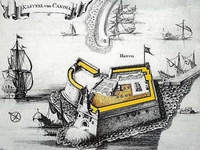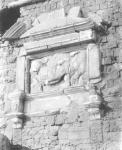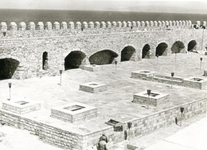

The impact of the sea-corrosion on the monument and on the materials of
the restoration of the ‘70ies was already obvious by the beginning of the
second millennium. From 2003 onwards the
13th Ephorate of Byzantine Antiquities prepared a restoration
project to deal with corruption of the battlements, deterioration of the stone
surface and mortar fillings, cracks, insoluble salt crusts, corrosion of the
iron parts, (i.e. the
reinforcement of the concrete roofing of the terrace buildings, the clamps
holding together the decorative elements, such as the marble emblems of Venice
on the facades, and the iron parts of doors and grids of the canon-openings), the penetration of rain and sea water through the skylight windows and
the sea humidity, the corrosion and destruction of the electricity and water installations and the absence of adequate visitor facilities.
In 2010 two separate plans of the Ephorate, for the restoration of the building
and the conservation of the stone surfaces respectively, were approved by the
Ministry of Culture.
The project for the “Restoration and Conservation of the Venetian
Fortress (Kules) of Heraklion”, which lasted from 2011 to 2016 was financed by
the NSRF with 2.050.000€ and by the State Fund with 120.000€. The campaign was initially
conducted by the Fund for the Management of Credits for Archaeological Works,
and from June 2013 by a Scientific Commission subjected to the 13th
Ephorate of Byzantine Antiquities (actually Ephorate of Antiquities of
Heraklion). The project included three
categories of interventions; a. restoration of
the building, b. conservation of the stone surfaces, c. visitor facilities.
More specifically, during the restoration campaign the walls of the building
were reinforced (new mortar fillings, stabilization of structure through injections,
masonry fillings), the roofs of the terrace buildings, the battlements constructed in the ‘70s and part of the parapet were
demolished and reconstructed, the battlements’ corridor was
restored, the skylight windows were replaced, the iron parts and
clamps of the doors were replaced
with stainless steel
and the wooden parts were conserved, the shutters of the
cannon-openings were replaced
with windows and
their iron grids were replaced
with stainless steel.
The surface conservation works included chemical and mechanical cleaning for
the removal of the soluble and insoluble salts (black crusts) and stains of
bio-deterioration, stabilization of structure, filling of cracks, adhering and
joining of broken parts with titanium bars.
To improve visitor facilities the hygiene
facilities at both
ground level and terrace were fully reconstructed, equipment for a refreshment
point and a small open-air theater on the terrace was provided, new electricity, water, drainage and internet infrastructures were installed, a full
access to both levels of the fortress for people with disabilities was granted,
a small congress and projection room was created at the ground level, info
points and information panels were placed, a web-site applicable in mobile
devices was designed and finally, two
study rooms for scholars of sculpture and pottery of the Venetian era as well
as an exhibition dedicated to sub-water archaeological research in the gulf of Heraklion were created.
 | 2. The Sea-Rock (La Rocca a Mare) | |
|---|---|---|
 | 2.1 Sea-Fortress. The history of the construction | |
 | 2.2 The relief emblems of Venice | |
 | 2.3 The older restoration campaigns of the 20th c. |